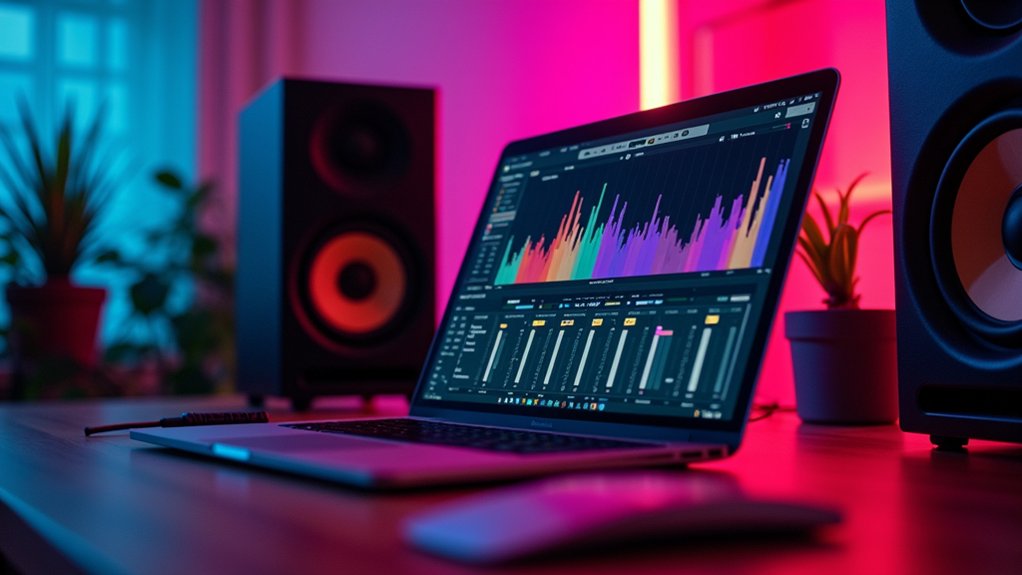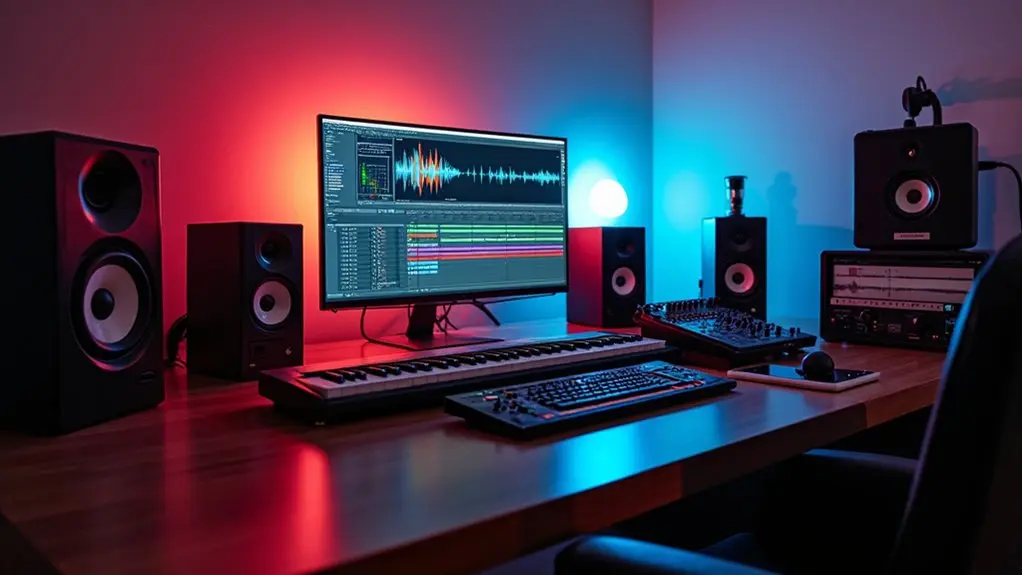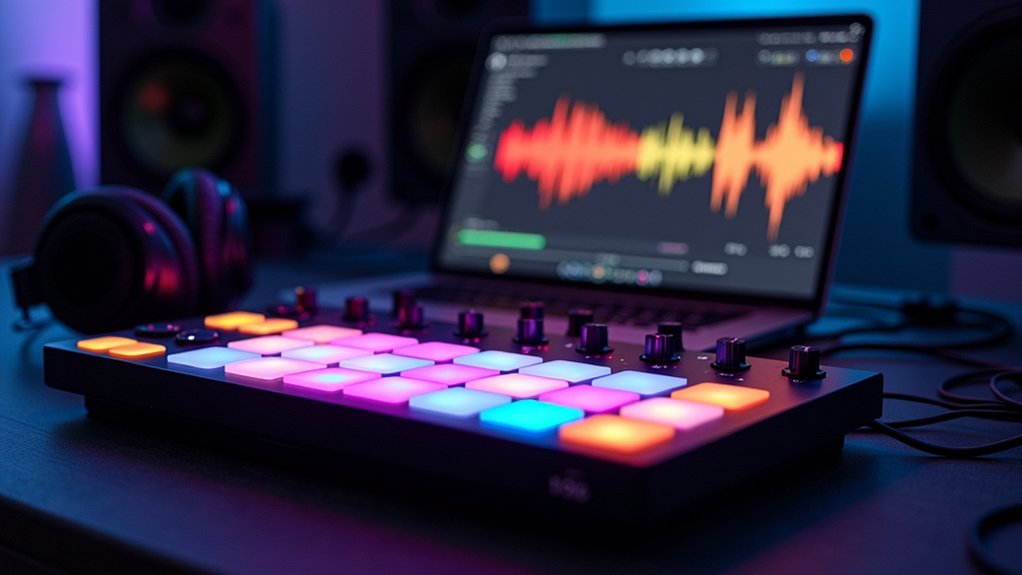Choosing between Studio One and Ableton Live depends on workflow requirements, hardware integration, and creative priorities. Studio One’s single-window interface, advanced track color coding, and seamless Faderport 8 integration enhance tactile mixing and visual clarity. Ableton excels in real-time manipulation and MIDI mapping, favored for clip-based composition and live performance. Both provide robust native effects, though Studio One offers streamlined plugin organization. Evaluation of upgrade paths and unique toolsets will ultimately guide the best DAW decision, detailed further below.
Key Takeaways
- Studio One offers a streamlined single-window interface, while Ableton Live features a dual-layout system optimized for live performance and real-time beat creation.
- Studio One provides superior hardware integration with devices like Faderport 8, enhancing tactile mixing and workflow efficiency.
- Track organization and color customization are more advanced in Studio One, aiding faster navigation and visual clarity during complex projects.
- Studio One’s plugin management is more user-friendly, offering quick identification and better workspace customization compared to Ableton Live’s horizontal FX layout.
- Studio One generally has more affordable pricing and upgrade paths, while Ableton Live’s full feature set requires higher initial investment.
Understanding What a DAW Is and Why It Matters
A Digital Audio Workstation (DAW) functions as the foundational platform for contemporary audio production, integrating signal recording, editing, arrangement, and mixing within a unified digital interface. The DAW serves as the primary environment in which music production occurs, enabling users to capture audio through multitrack recording, manipulate signals via editing tools, and layer compositions using software instruments and MIDI sequencing. DAWs support diverse audio formats and seamlessly interface with hardware such as audio interfaces and MIDI controllers, facilitating both virtual and acoustic sound sources. Distinct DAWs provide specialized feature sets; for example, advanced score editors cater to composers, while modular workflows enable sound design experimentation. Selecting an appropriate DAW is critical, as it shapes the user’s creative process, technical efficiency, and overall productivity in music production. Additionally, the user interface design of a DAW can dramatically impact the ease and speed at which a producer can navigate and utilize its features.
Comparing Workflow and Interface Design
Selecting a DAW shapes not only the available feature set but also dictates workflow efficiency and interface navigation.
Studio One employs a single-window interface design, streamlining signal flow from recording to processing and arrangement. This architecture allows dedicated screens for functions such as the console and plugin racks, enhancing workflow efficiency by reducing window management.
Automated color management in Studio One provides clear visual organization across tracks, minimizing cognitive load and potential confusion. Quick access to FX with interactive previsualizations further accelerates production tasks.
In contrast, Ableton Live’s dual-layout system, splitting arrangement and clip views, introduces a more rigid interface design. Horizontal scrolling for FX and less intuitive color management can slow down navigation, impacting overall workflow efficiency during complex music production sessions.
Evaluating Hardware Integration and Tactile Control
Evaluating hardware integration and tactile control requires examination of motorized fader workflow, controller compatibility options, and hands-on mixing experience.
Motorized faders such as those on the Faderport 8 enable precise real-time adjustments in signal flow, while dedicated hardware controllers like Push 2 offer responsive parameter manipulation.
The degree of seamless interaction between hardware and DAW interface directly impacts operational efficiency and user ergonomics.
Motorized Fader Workflow
While many digital audio workstations rely on mouse and keyboard input, integrating a motorized fader controller such as the Faderport 8 with Studio One greatly enhances tactile workflow efficiency. The motorized fader workflow leverages real-time parameter adjustments, reducing reliance on indirect mouse clicks and enabling precise control over signal flow. Studio One’s single-window layout, combined with Faderport 8’s visual feedback—such as track color displays—optimizes session navigation and minimizes cognitive load. Users frequently cite the ergonomic improvement and hands-on approach as transformative, especially during complex mix sessions. This seamless integration stands in contrast to Ableton Live, where such tactile control is less natively emphasized.
| Studio One + Faderport 8 | Ableton Live (Mouse) |
|---|---|
| Tactile, responsive mix | Click-driven workflow |
| Visual track colors | Limited visual cues |
| Reduced cognitive load | Manual track search |
| Intuitive signal flow | Fragmented navigation |
Controller Compatibility Options
Although digital audio workstations increasingly support a range of external hardware, the degree and nature of controller compatibility remain critical to workflow optimization.
Studio One exhibits streamlined integration with its proprietary Faderport 8, enabling motorized fader control directly synchronized with the DAW’s signal flow, thereby minimizing reliance on traditional input devices. Customizable hardware integration in Studio One allows adaptation to specialized production requirements, supporting various controller options for precise manipulation of third-party plugins.
Conversely, Ableton Live’s architecture facilitates extensive MIDI mapping, accommodating a broad spectrum of controllers, such as the Push 2, which provides a responsive tactile interface suited for electronic music workflows.
Both DAWs’ visual layouts—Studio One’s single-window and Ableton’s dual-view—directly influence the intuitive deployment and interaction with connected hardware controllers.
Hands-On Mixing Experience
Optimizing the hands-on mixing experience necessitates robust hardware integration and responsive tactile control within the chosen DAW environment.
Studio One’s synergy with the Faderport 8 provides motorized faders and a dedicated track color display, resulting in precise tactile feedback and streamlined workflow. This hardware integration enables users to execute real-time signal flow adjustments without excessive reliance on keyboard or mouse, supporting efficient level balancing and effects manipulation.
In contrast, Ableton Live’s compatibility with Push 2 affords a tactile, instrument-like interface, facilitating expressive control during both studio production and live performance.
Both DAWs deliver extensive hardware control, yet Studio One’s single-window layout and ergonomic integration are often cited as superior for mixing tasks.
Ultimately, enhanced hardware integration boosts the precision and expressivity of the hands-on mixing experience.
Organizing Tracks: Color Coding and Visual Management
Track color customization plays a critical role in optimizing signal flow and enhancing visual workflow efficiency within a DAW environment.
Effective color coding facilitates rapid identification and organization of audio, MIDI, and auxiliary tracks, particularly in large sessions with complex routing.
Comparative analysis reveals that advanced visual management tools can greatly reduce navigation time and cognitive load during intricate production tasks.
Track Color Customization
Efficient visual management within a digital audio workstation (DAW) relies heavily on robust track color customization, directly impacting workflow and cognitive load.
Studio One offers extensive track color customization, allowing users to assign distinct colors to entire tracks. This approach enhances signal flow clarity and streamlines identification of individual elements within complex projects.
Integration with hardware such as the Faderport 8 further amplifies this advantage, as track colors are mirrored on physical controls, resulting in reduced cognitive strain during session navigation.
In contrast, Ableton Live’s color management is more automated and clip-oriented, which may hinder holistic track organization and introduce confusion in large or intricate arrangements.
Consequently, Studio One’s effective color scheme facilitates improved workflow, rapid project navigation, and minimized visual clutter for advanced production environments.
Visual Workflow Efficiency
Clarity in visual workflow is essential for minimizing cognitive overhead and maintaining signal flow integrity within a digital audio workstation. Studio One exemplifies visual workflow efficiency through robust color customization, allowing users to assign and modify track colors with precision, directly impacting track management and project organization. In contrast, Ableton Live’s automated color management can introduce ambiguity, potentially impeding quick track identification. The integration of Faderport 8 with Studio One further enhances usability by mirroring track colors in hardware, whereas Ableton’s approach is less intuitive.
| Feature | Studio One | Ableton Live |
|---|---|---|
| Track Color Control | Manual, customizable | Automated, limited |
| Hardware Integration | Faderport 8 color sync | Minimal |
| Screen Layouts | Flexible, dedicated views | Dual-layout, rigid |
| Cognitive Load | Reduced via daily color use | Potentially increased |
Visual workflow efficiency in Studio One directly supports streamlined track management.
Managing Large Sessions
Steering complex sessions demands robust organizational tools that minimize cognitive overhead and facilitate rapid signal flow assessment.
When managing large sessions using software, Studio One offers advanced color customization across entire tracks, streamlining visual management and enhancing track differentiation. This granular control surpasses Ableton Live’s automated color management, which can introduce ambiguity in extensive projects.
Studio One’s integration with the Faderport 8 further amplifies visual clarity by reflecting track colors directly on hardware, optimizing user navigation. Customizable screen layouts in Studio One allow for dedicated zones—such as for the console, arrangement, or plugins—permitting more efficient management of session elements.
Additionally, Studio One’s ability to hide unused plugins and display thumbnails maintains workspace clarity, directly supporting workflow optimization in large-scale productions.
Plugin Management and Native Effects
Many aspects of digital audio workstation (DAW) workflow depend on how effectively plugins and native effects are managed within the software environment.
Studio One’s approach to plugin management is optimized for speed and clarity, utilizing interactive previsualizations and thumbnail generation to facilitate quick identification and selection. In contrast, Ableton Live’s horizontal scrolling for effects can hinder efficient signal flow, impacting workflow fluidity.
Studio One allows unused plugins to be hidden, supporting a streamlined and organized workspace. Its native effects, including reverbs and delays, are recognized for high sound quality and thoughtful interface design, offering a technical edge over Ableton’s more static VST selection.
- Interactive previsualizations in Studio One
- Plugin thumbnail generation for easy recognition
- Hide unused plugins for streamlined workflow
- High-quality native effects in Studio One
- Enhanced plugin display options for efficient organization
Built-in Instruments and Sound Quality
Instrument selection and native sound quality constitute pivotal factors in evaluating a digital audio workstation’s production capabilities.
Studio One integrates built-in instruments such as Presence XT and Mai Tai, providing a versatile palette of acoustic and synthesized timbres suitable for multi-genre production workflows. Its native effects, especially reverb and delay, yield high-fidelity processing that enhances the perceived clarity and spatial imaging of the mix.
Studio One’s streamlined interface allows rapid auditioning and application of effects, optimizing signal flow for efficient sound design.
Conversely, Ableton Live’s suite, including Analog, Wavetable, and Sampler, emphasizes real-time sound manipulation, appealing to electronic music producers. However, horizontal FX browsing can disrupt workflow continuity.
Ultimately, the comparative sound quality and instrument selection cater to distinct creative priorities and genre requirements.
Pricing, Versions, and Upgrade Paths
While both Studio One and Ableton Live employ tiered licensing structures, the specific pricing and available upgrade paths introduce notable distinctions impacting user adoption and long-term investment.
Studio One’s versions range from the free Prime to the mid-tier Artist ($99) and the flagship Pro ($399), each offering incremental signal processing and integration features.
Ableton Live’s pricing schema includes Intro ($99), Standard ($449), and Suite ($749), with higher tiers revealing advanced devices and workflow options.
The upgrade ecosystem and licensing flexibility influence user retention and DAW migration.
- Studio One Artist requires a $50 add-on for third-party plugin support.
- Ableton Live’s major version upgrades can incur significant costs.
- Studio One typically offers more affordable upgrade paths and discounts.
- Both platforms provide time-limited trial versions.
- Feature sets scale predictably with each pricing tier.
Unique Features for Creative Production
A streamlined user interface and advanced organizational tools distinguish Studio One and Ableton Live in the domain of creative production.
Studio One’s unique features include a single-window layout that optimizes signal flow, reducing window management and enabling seamless management of recording, processing, and track arrangement. Flexible screen layouts support dedicated workspaces for console, arrangement, and plugins, enhancing ergonomics. Color customization empowers users to visually organize tracks, decreasing cognitive load while making music.
Advanced plugin management, featuring interactive previsualizations and thumbnail generation, accelerates FX identification compared to Ableton’s horizontal scrolling approach. Studio One also streamlines mid/side mixing and audio manipulation, offering inspiring high-quality native plugins.
In contrast, Ableton Live’s dual-layout and automated color management can hinder workflow efficiency for certain users, impacting creative output.
Community Insights and User Experiences
User engagement within music production communities provides actionable context for DAW selection, supplementing technical specifications with real-world workflow insights.
Objective analysis of community discussions reveals that users’ choices often stem from hands-on experience with personal projects and peer recommendations. The iterative exchange of workflow strategies and troubleshooting methods creates a knowledge base supporting both novice and advanced producers.
Critical points from these user-driven forums include:
- Sharing of personal projects, highlighting DAW strengths for specific genres or workflows.
- Reports on shifting between Studio One and Ableton, emphasizing signal flow and compositional paradigms.
- Recommendations to utilize trial versions for empirical workflow assessment.
- Documentation of community-driven tutorials and troubleshooting, enhancing feature navigation.
- Ongoing dialogue about software updates, informing collective understanding of evolving DAW capabilities.
These insights inform precise, context-driven DAW selection.
Frequently Asked Questions
Which DAW Is Better Than Ableton?
Determining which DAW is superior depends on workflow requirements; Studio One features streamlined signal flow, advanced plugin management, and customizable organization, while Ableton advantages include session view flexibility and live performance integration, catering to distinct production environments and user preferences.
Why Do People Prefer Ableton Over FL Studio?
Preference for Ableton over FL Studio often stems from its streamlined workflow efficiency, advanced session view for non-linear music production, real-time audio manipulation, and superior hardware integration, facilitating rapid signal flow and creative experimentation within professional production environments.
Can I Use Studio One for Live Performance?
Studio One can be used for live performance, offering performance features such as real-time clip triggering, setlist management, and seamless hardware integration. Its signal flow supports VST processing, providing flexibility and control suitable for live stage environments.
Is Studio One as Good as Pro Tools?
The current question examines whether Studio One features measure up to Pro Tools. Objectively, Studio One offers advanced signal flow options, streamlined workflow, and a robust audio engine, making it a competitive alternative in a Pro Tools comparison.
Conclusion
To conclude, both Studio One and Ableton offer robust DAW environments, each excelling in distinct areas of workflow, signal routing, and plugin management. Studio One prioritizes streamlined linear arrangements and intuitive visual organization, while Ableton emphasizes real-time performance, session view flexibility, and modular signal flow. The best choice hinges on the user’s production requirements, preferred interface paradigms, and integration needs. Objective assessment of feature sets and workflow efficiency remains critical in selecting the most suitable digital audio workstation.




